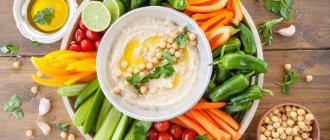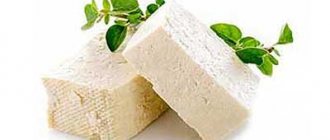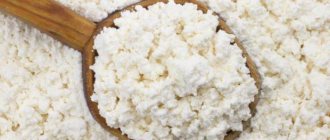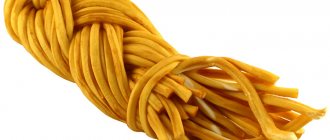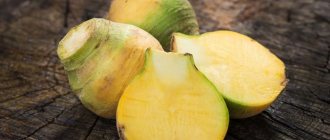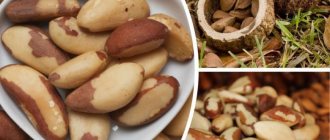Calories, nutritional value, vitamins and minerals
248 kilocalories in every 100 grams , which is not surprising given the high concentration of fat and proteins in it.
This fact determines the high nutritional value of the duck product. Her muscles mainly consist of dry matter, which they contain three times more than water.
In terms of indicators indicating how biologically complete a particular product is, duck meat is 20% ahead of beef. Almost all proteins (98%) of duck are complete proteins.
Another main element that determines the nutritional value of duck is its almost perfect balance of beneficial amino acids.
For example, the unsaturated fatty acids present in the product, which serve as antioxidants and reduce the level of bad cholesterol in the blood, are ahead of chicken, pork and beef in this indicator.
Composition and nutritional value of duck meat
Comparing duck with pork, beef and chicken, scientists concluded that it is superior to other analogues in many respects. Mulard and turkey meat, in turn, has several advantages over traditional homemade products. Considering the composition of raw materials, regardless of their type, the following substances can be noted:
Let's start with soup, it's low in calories and will satisfy your first hunger, so reduce your appetite for other dishes. Let's also go for sauerkraut with mushrooms and salads, and avoid or strictly limit the most high-calorie dishes. First, however, let's look at the amount of sweetened sweets and alcohol. Confectionery is a source of fat and sugar, which is quickly stored as adipose tissue, and alcohol, when drunk, causes food to be placed in the body's "shops", suggests the nutritionist.
So enjoy your delicious Christmas food - but do it in moderation. This will make it easier for us to fit in the New Year's creations. In my home parish, the holiday is an opportunity to meet with family and try the geese prepared by my mother. Maria Kovalchik: Is goose liver a fatty meat? Is it true that goose fat is best absorbed by the human body?
- Vitamin A. A chemical compound that people living in the modern world really need. It protects the mucous membrane of the nose, eyes and ears from infection. Promotes its rapid recovery and normal hydration.
- Vitamin B1. A deficiency of this substance can cause loss of appetite, bad mood, chronic fatigue and insomnia.
- Vitamin B2. Thanks to this vitamin, the benefits of duck meat extend to maintaining healthy nails, skin and hair. Another substance takes an active part in lipid metabolism.
- Iron. A chemical element necessary to maintain normal hemoglobin levels. With its deficiency, a person develops anemia, which is characterized by severe weakness and general deterioration of the condition.
Poultry fats are considered healthier than slaughtered animals due to their fatty acid composition. They have a lower melting point and are easier to emulsify, making them more absorbable. In general, however, it is believed that excess saturated fatty acids in the diet are bad and should be reduced locally by introducing vegetable fats - oils, nuts, seeds or, for example, avocados.
How to combine goose meat to make a complete and nutrient-rich Christmas meal? Mandatory with vegetables - preferably fresh or steamed al dente. Vegetables can be sprinkled with yoghurt sauce, lemon juice, or with a little fat - for example, rapeseed oil. For this, brown or wild rice, or cereals - for example, buckwheat or yogurt. You can also stuff the bird with mashed potatoes and nuts.
Tip: When working with duck meat of any type or variety, it is recommended to use sea salt rather than table salt. This will get rid of the specific smell of mud, if any. This ingredient will make clean meat even more juicy and flavorful.
- Unsaturated fatty acids. According to this indicator, duck is ahead of pork, beef and chicken. The substances reduce levels of bad cholesterol in the blood and neutralize its danger to the heart and blood vessels. A deficiency of these acids in childhood leads to inhibition of physical and mental development, and in old age - to the risk of signs of senile dementia.
During heat treatment, the listed substances are not destroyed. Some of them even change their shape, thanks to which they are only more actively and fully absorbed by the body.
This depends on the size of the portion and what additives were used - for example, whether it was poured with melted butter, stuffed or stuffed with dried fruit. Are duck and goose the same type of meat or completely different in terms of nutritional value? Goose and duck meat are quite high in calories, which is due to their higher fat content than other types of poultry. These birds, due to their high fat content, protect against cold water. Better yet, focus on the valuable meat and skip the skin, which contains in addition to fat, cholesterol and fat-soluble toxins that the bird has encountered in its life.
Taste qualities
Not only the high nutritional value of duck allows it to occupy one of the main places in human culinary preferences for centuries, but also its undoubted taste. Its dark meat is not classified as dietary, but it is used very widely throughout the world for gastronomic purposes and is recommended for almost all categories of healthy people.
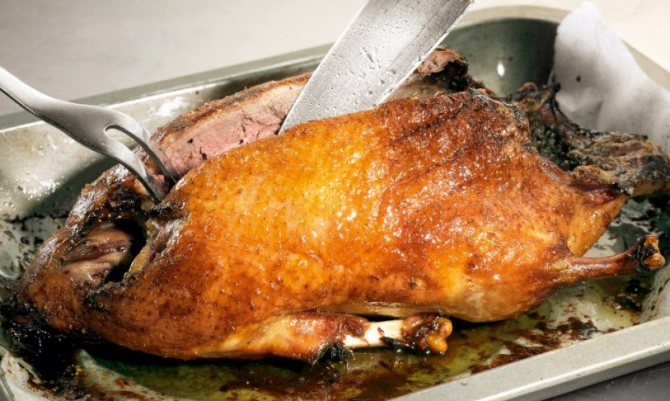
Duck meat, regardless of the method of preparation, invariably has a specific taste, a unique aroma and a pleasant aftertaste. More subtle differences in duck product depend on the breed of bird and its age. In six-month-old ducklings, the meat is more tender and less fatty, while in adult ducks it is tougher and fattier, but it has additional taste and is more flavored with specific duck smells that cannot be confused with anything else.
Composition and calorie content of duck
100 g of duck contains 73.77 g of water, 18.28 g of proteins, 5.95 g of fat, 1.06 g of ash, 0.94 g of carbohydrates; vitamins: retinol (A), thiamine (B1), riboflavin (B2), niacin (PP), pantothenic acid (B5), pyridoxine (B6), folic acid (B9), ascorbic acid (C), cyanocobalamin (B12), calciferol (D), alpha-tocopherol (E), choline (B4), phylloquinone (K); trace elements: selenium, zinc, copper, manganese, iron; macroelements: phosphorus, sodium, magnesium, calcium, potassium.
Duck has a high calorie content, approximately 350-400 kcal per 100 g of product.
What are the benefits of duck meat?
The saturation of duck meat with vitamins, minerals, organic acids, proteins and fats determines its usefulness for the human body.
Particularly noteworthy is the specific duck fat , which is considered by nutritionists to be more valuable than butter, and is equated by its qualities to olive oil. It contains a lot of saturated, mono- and polyunsaturated Omega-3 and Omega-6 fatty acids, which act as effective antioxidants.
Another unique property of duck fat is its low melting point , which is much lower than human body temperature. This property helps the body to easily get rid of its excess.
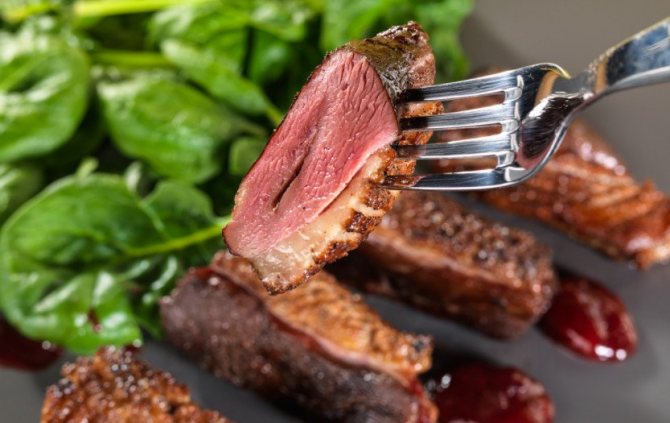
- an effective antioxidant due to its high selenium content, which protects cells from the harmful effects of free radicals. Almost half the daily requirement of this element is contained in just 100 g of duck meat;
- a remedy that combats anemia. A set of nutrients from phosphorus, iron and vitamin B12 fills the body with energy and increases the hemoglobin content in the blood;
- means that strengthen the immune system. The presence of organic fatty acids, as well as zinc and selenium, which act as powerful antioxidants, significantly enhances human immunity;
- optimizer of the state of the nervous system. The most important B vitamins contained in the product, as well as copper, normalize the functioning of the nervous system in the body;
- fighter against excess weight. Vitamins from the same group B, as well as polyunsaturated Omega-3 and Omega-6 fatty acids, activate metabolic processes in the body and inhibit the concentration of fats in the human body. The same purpose is served by the presence of zinc, which promotes a more active production of enzymes that play a decisive role in metabolic processes. In addition, the high percentage of protein content in the product creates a feeling of satiety in the body for a long time, inhibiting the intake of excess food and thereby promoting weight loss;
- products that promote healthy hair and skin. Thanks to the presence of niacin, riboflavin, Omega-3 and Omega-6 fatty acids, the skin and hair receive complete nutrition and acquire a healthy and attractive appearance.

- bad cholesterol in the blood;
- the risk of problems in the cardiovascular system;
- osteoporosis and other bone diseases;
- diabetes;
- metabolic problems;
- decreased body tone;
- reducing the body’s activity in the production of enzymes;
- problems related to pregnancy;
- danger of malignant formations;
- deterioration of visual acuity.
Did you know? The famous duck quack belongs exclusively to the female half of the population, and the drakes are mute and unresponsive.
In addition, quacking does not cause any echo, which baffles physicists.
Chemical composition of duck meat
Healthy duck meat contains microelements, macroelements, vitamins of groups B, A, C, E, K. Each group has its own functions and properties. One of the first most important elements is iron. It is found in moderation in duck and makes it healthy.
It is this element that tends to be responsible for the level of hemoglobin in the blood. Otherwise, the person suffers from anemia. Without it, vitamins are not absorbed in normal quantities. For these processes to proceed normally, a person needs 20 milligrams per day. But it is advisable for the female body to consume half more, because it loses blood during menstruation.
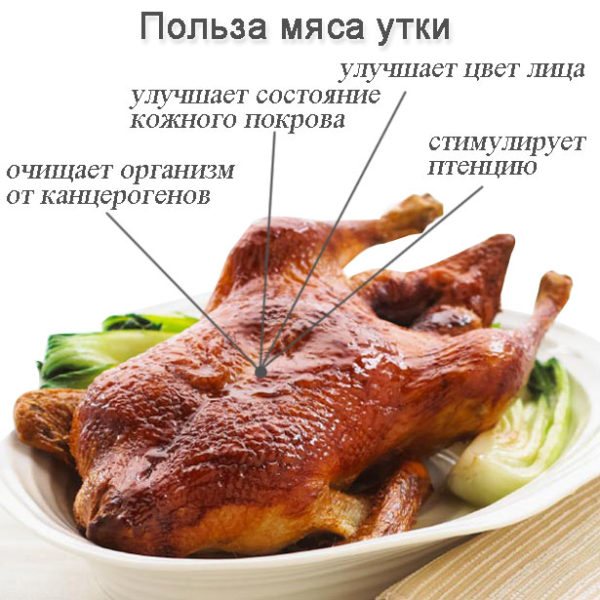
Vitamin A is beneficial for normal vision. This is one of the most important properties that a child’s body needs. In the age of modern technology, this is important. The element helps treat dermatological diseases. B1 normalizes appetite, energizes, reduces the risk of insomnia, and guarantees normal mood. B2 is a truly feminine vitamin. It helps maintain the beauty of nails, hair, skin, and normalizes metabolism.
Unsaturated acids are found in large quantities in this meat, more of them than in chicken, veal, and pork. They are of great importance for those who suffer from high cholesterol. After all, they tend to reduce its harm. If unsaturated acids are present in small quantities in the body, there is a risk of heart, brain and artery diseases.
Is it possible to eat
Nutritionists believe that in the absence of individual intolerance to duck meat, it can and even should be consumed by all healthy people. However, in some cases there are peculiarities in the use of duck.
Pregnant
The main task in the nutrition of a pregnant woman is not to harm the fetus and not forget about her own health. Duck meat copes well with both of these tasks, if, of course, pregnancy proceeds without any pathologies.

Nursing mothers
But women during lactation should be more careful when using this product. The reason is its fat content, as a result of which, after eating duck, a nursing woman increases the fat content of breast milk. And this is not suitable for every baby. Some of them have problems with the digestive system, which prompts babies to refuse breastfeeding.
In this regard, leaner wild duck meat is much preferable, however, due to its inaccessibility for the vast majority of nursing mothers, it cannot be promoted as an alternative to domestic duck, so one has to be content with a poultry product. It is recommended to remove the skin and subcutaneous fat from the duck carcass . When such meat is baked, the rest of the fat is rendered out of it.

However, duck meat can be introduced into the diet of a nursing mother only after the baby is three months old. In this case, the first portion of the product should weigh a maximum of 50 g. If within 24 hours after this the baby does not experience any problems, the portions can be gradually increased, not forgetting to supplement the duck meat with vegetables and herbs.
Important! In any case, a nursing woman should not get too carried away with duck meat.
Losing weight
Regarding whether duck meat is harmful for overweight people or, on the contrary, it promotes weight loss, nutritionists have not yet developed a consensus.
Some believe that the presence of B vitamins in duck meat, as well as polyunsaturated Omega-3 and Omega-6 fatty acids, activates metabolic processes in the body and inhibits the concentration of fats in the human body. This is also facilitated by the presence of zinc, which activates the production of enzymes that play a decisive role in metabolic processes. As a result, eating duck should lead to weight loss.

Others, on the contrary, are sure that the fatty duck product adds extra calories and leads to the accumulation of unnecessary fat in the human body, and therefore recommend that those who want to lose weight abstain from this product.
Obviously, as always, the truth lies somewhere in the middle between these polar opinions. Most likely, those who consider the effect of a duck product on a person to be a purely individual process, which a person must find out for himself based on his own feelings or with the help of a doctor, are more right.
Tips for livestock farmers: become familiar with the meat breeds of pigeons, chickens, pigs, cows, and rabbits.
How many calories are in duck
Almost every day a person consumes meat in his diet. Depending on individual needs and capabilities, this may be beef, pork, poultry or fish. Everyone is guided by their own capabilities and needs. Duck meat is considered very nutritious and satisfying. This is a natural product that is rich in useful ingredients and saturates the human body with everything it needs. It is also worth remembering that duck is a fatty meat and is not a dietary product at all, so consuming it during a diet is not recommended. It's best to stick to chicken fillet. Its composition is a large arsenal of vitamins and chemical elements.
The main beneficial substances that make up duck meat are:
- B vitamins (B1, B2, B6, B5);
- vitamin PP;
- vitamin A;
- vitamin E.
Chemical elements include the presence of cobalt, calcium, molybdenum, magnesium and fluorine, sodium, zinc, iron, chloride, sulfur and other useful elements. Duck meat has its advantages as well as disadvantages. The composition of meat is rich in elements such as betaine and choline, which contribute to the proper formation of the cell membrane. If you are a person suffering from diabetes or overweight, you are not recommended to eat duck meat, since it contains refractory fats that take a long time to break down.
Use in cooking
Over the thousand-year history of eating duck, people have accumulated many methods of culinary processing of the product and developed a rich recipe for duck dishes.
What can be done
Duck meat is subjected to stewing, frying, baking, smoking, salting, steaming and grilling . Most people know firsthand about duck stuffed with apples, although many other products are also used in the form of minced meat.
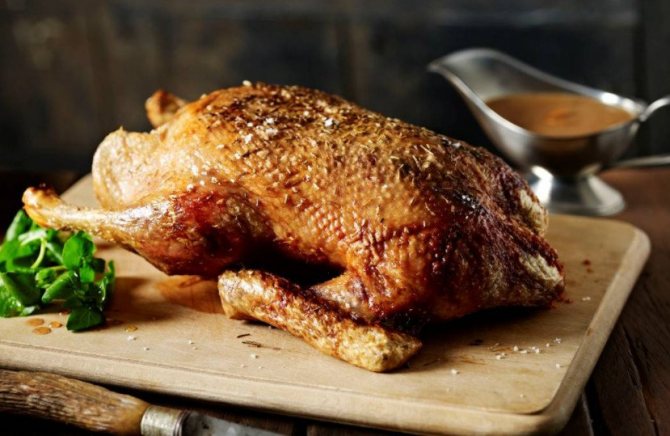
In addition to using the whole duck carcass, there are many recipes that use individual parts of the bird's body. In this form, duck is used for cooking various soups, preparing pilaf, roast, and stew.
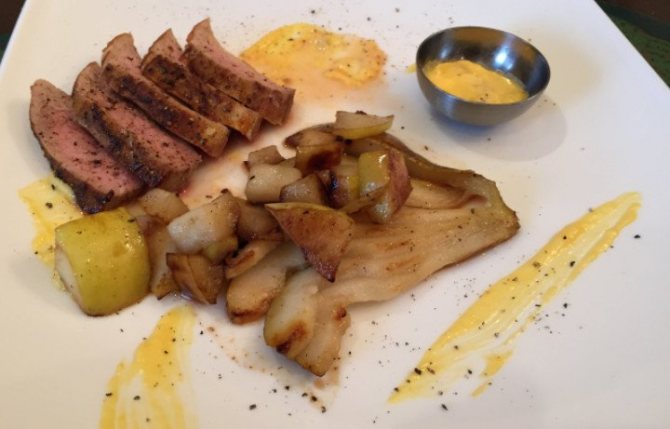
Duck giblets are also actively used for culinary purposes, for example, in the preparation of the famous foie gras. And, of course, we should mention one of the most popular duck dishes, which is served in most restaurants in the world - Peking duck.
What goes with it?
Duck meat goes well with almost all types of side dishes , and stuffing the carcass works best with sweet and sour apples, boiled potatoes, sauerkraut, pickled lingonberries, buckwheat porridge, rice, pasta, legumes, fruits, dried fruits and nuts.
Pomegranate and orange sauces , as well as ginger, parsley, thyme, and basil 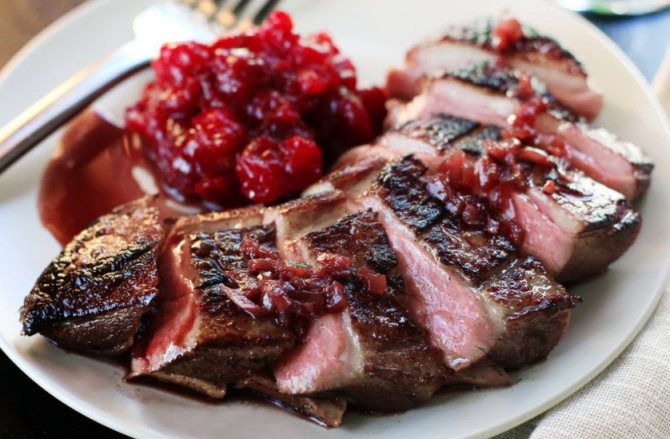
Learn how to make gooseberry sauce for meat or fish.
Duck with apples in the oven
1. In order to cook oven-baked duck with apples, first of all you need to choose a high-quality bird in a store or market. It is better to purchase a medium-sized carcass around 2 kg, since a too small duck is unlikely to be able to feed a dozen guests, and a large bird is often too fatty, and it usually grows due to hormones and other artificial additives. It is preferable to take a chilled duck, however, a frozen product is also quite suitable for preparing this dish, especially since thawed imported ducks are often sold in markets under the guise of fresh poultry. In appearance, the carcass should have a uniform light color without blood, bruises or forgotten feathers, and its smell should not contain sour or downright unpleasant notes. If the duck is sold in a sealed package, then only a small amount of moisture is allowed inside, although if it has been previously thawed, then the normal amount of liquid will be slightly more.
Duck purchased at the market or in a store should be thoroughly rinsed with running water, inside and out, dried with paper towels, and then rubbed with salt and pepper. In addition, the carcass should be inspected from the inside, since sometimes there is a bag of giblets carefully placed by the manufacturer, from which you can then cook an excellent soup, and in some cases, the giblets may remain in place and then they will have to be separated manually. You also need to keep in mind that a lot of fat often accumulates in the pelvic area of a duck carcass, most of which is best cut off to reduce the calorie content of this dish.
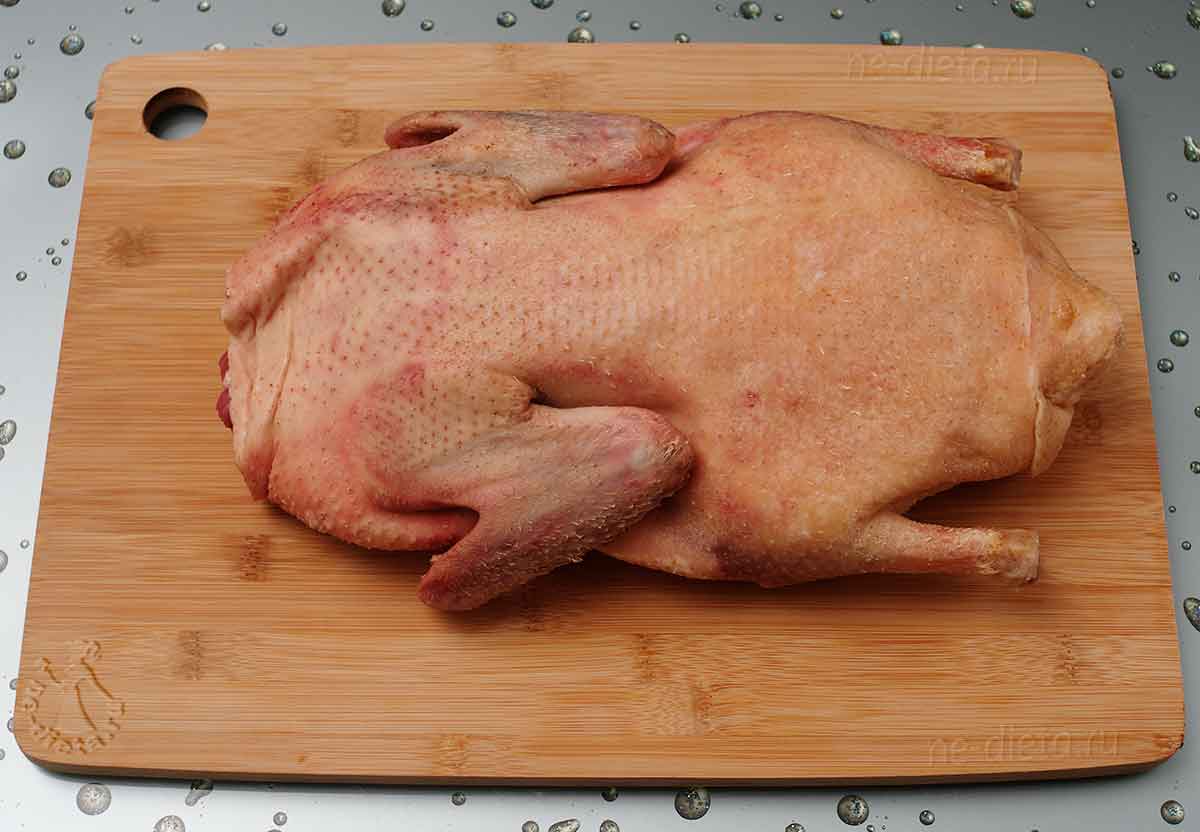
2. Wash the outside of the apples thoroughly, since they do not need to be peeled, but the middle with the seeds should be cut out, and then cut the fruits into medium-sized segments. Then the apples must be immediately poured with juice squeezed from half a lemon, otherwise they will darken very quickly.
Advice! To stuff a duck, you must definitely use sour or sweet and sour apples, the juice of which can further soften the meat fibers and give them a piquant taste and aroma. The best apples, of course, are the Antonovka variety, but in the absence of this rarity, you can take juicy green apples of the common Semerenko and Granny Smith varieties.
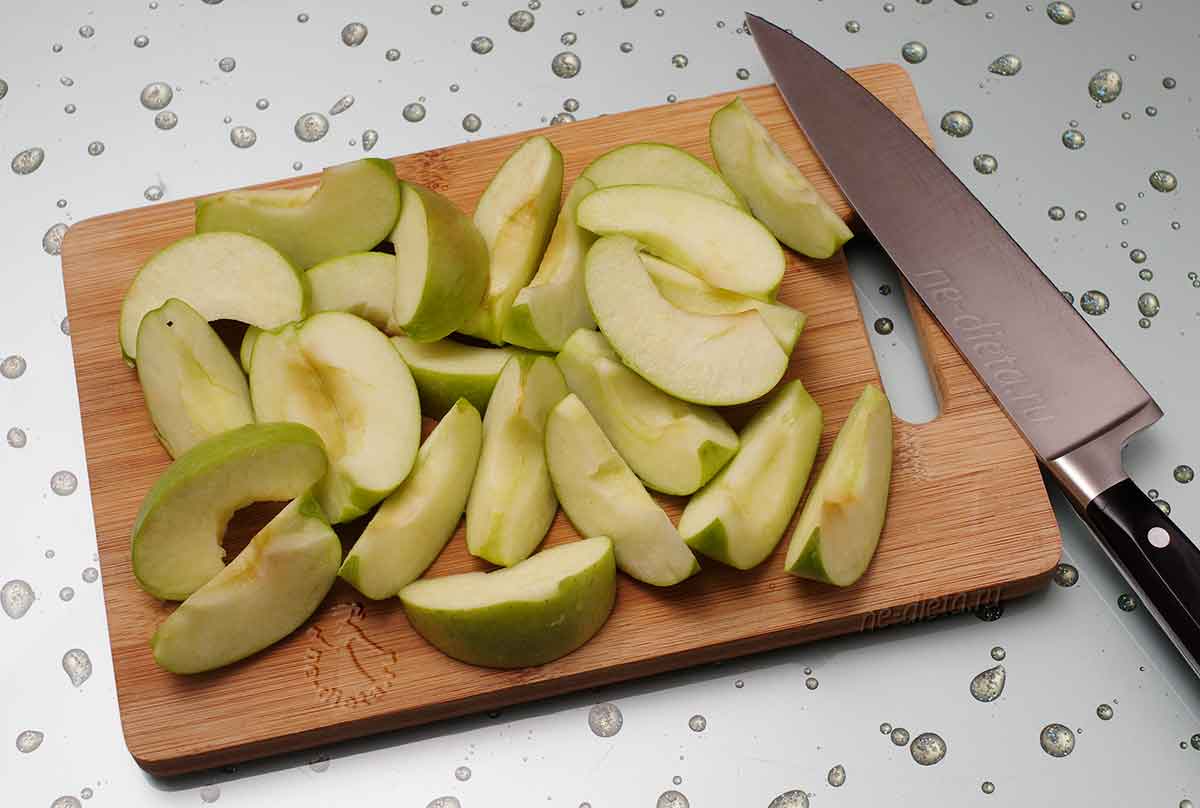
3. Next you need to prepare a honey glaze to soak the duck. To this end, melt the butter in a small bowl or saucepan and mix it with liquid honey, the juice of the remaining half of a lemon, as well as cinnamon and ginger. Mix all glaze components thoroughly with a fork to break up any lumps of dry spices.
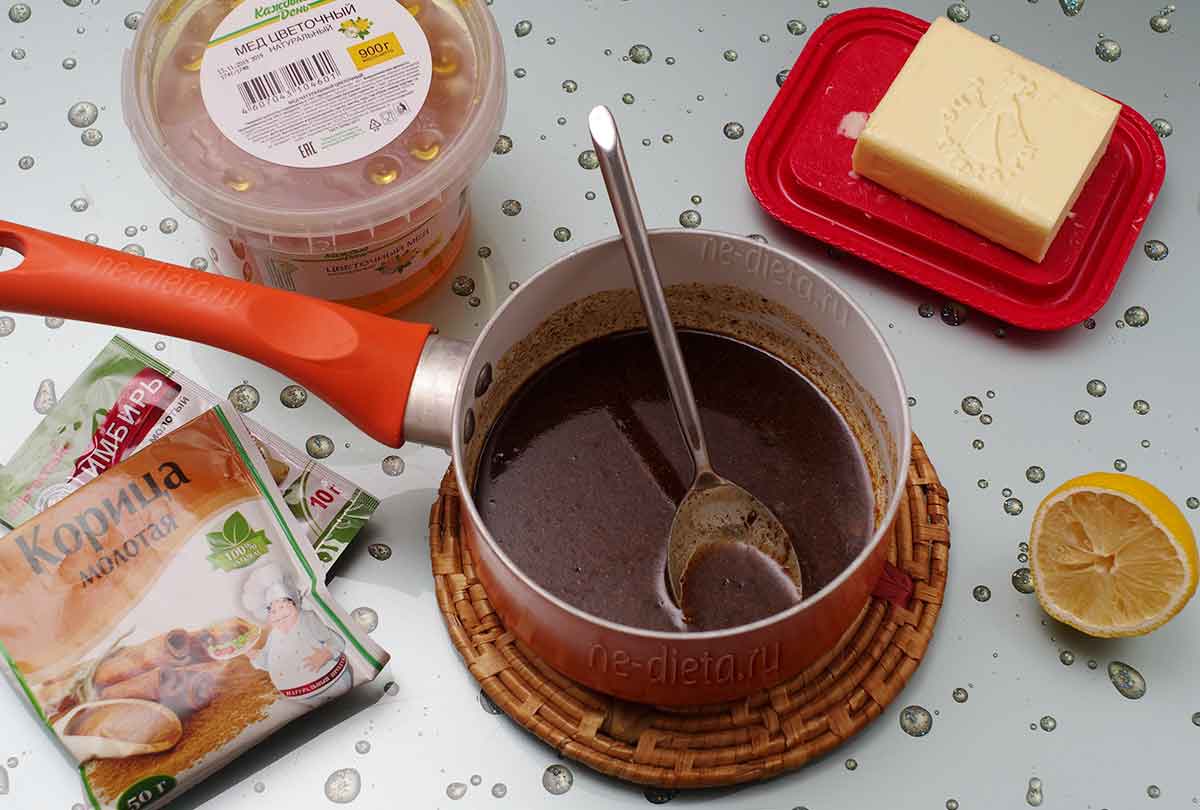
4. Rub the inside of the duck with honey glaze, stuff it tightly with apples and secure the hole with toothpicks or sew it up with thread. I joined the edges of the hole first with toothpicks as this is the easiest procedure, and then I wrapped the toothpicks with cooking floss and pulled the edges together lightly. In this case, there is no need to tightly sew the duck carcass, but you just need to ensure that the apples do not fall out of it.
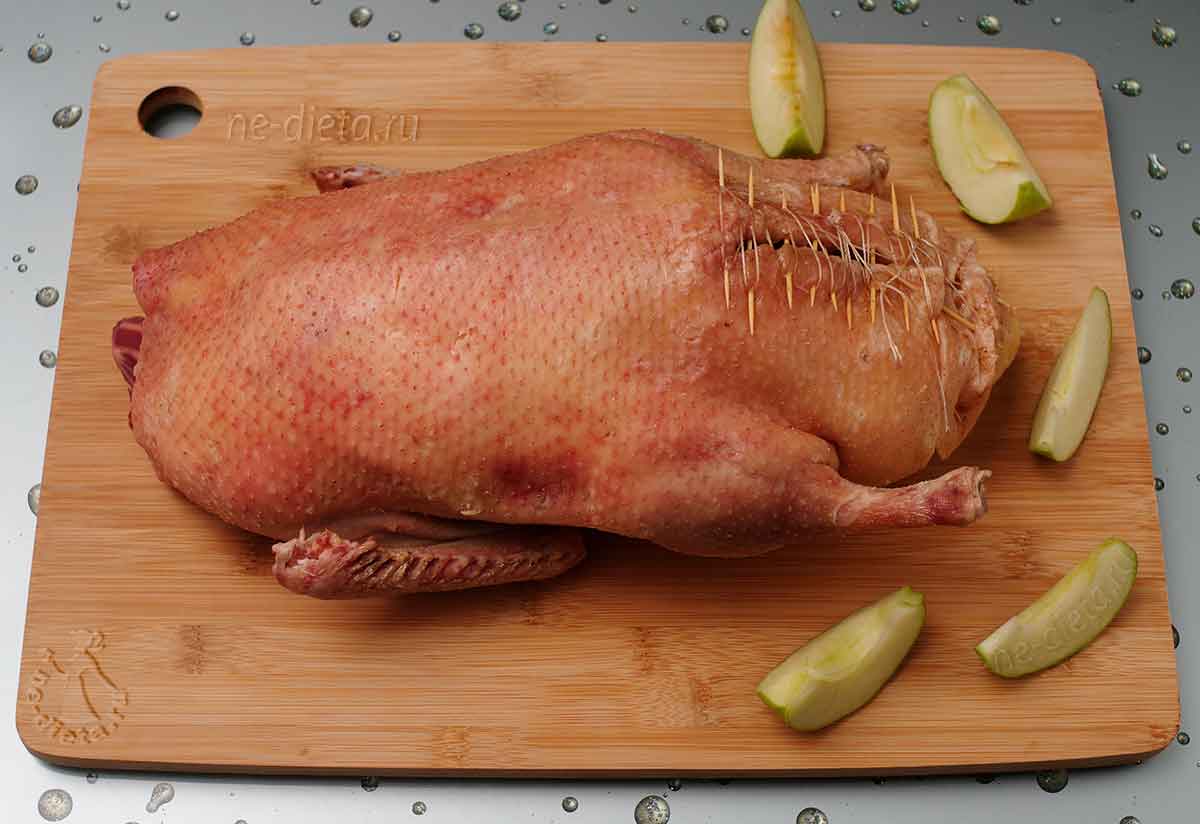
5. Wash the oranges well and cut into rings without peeling them, then place them overlapping on the bottom of the duckling pan.
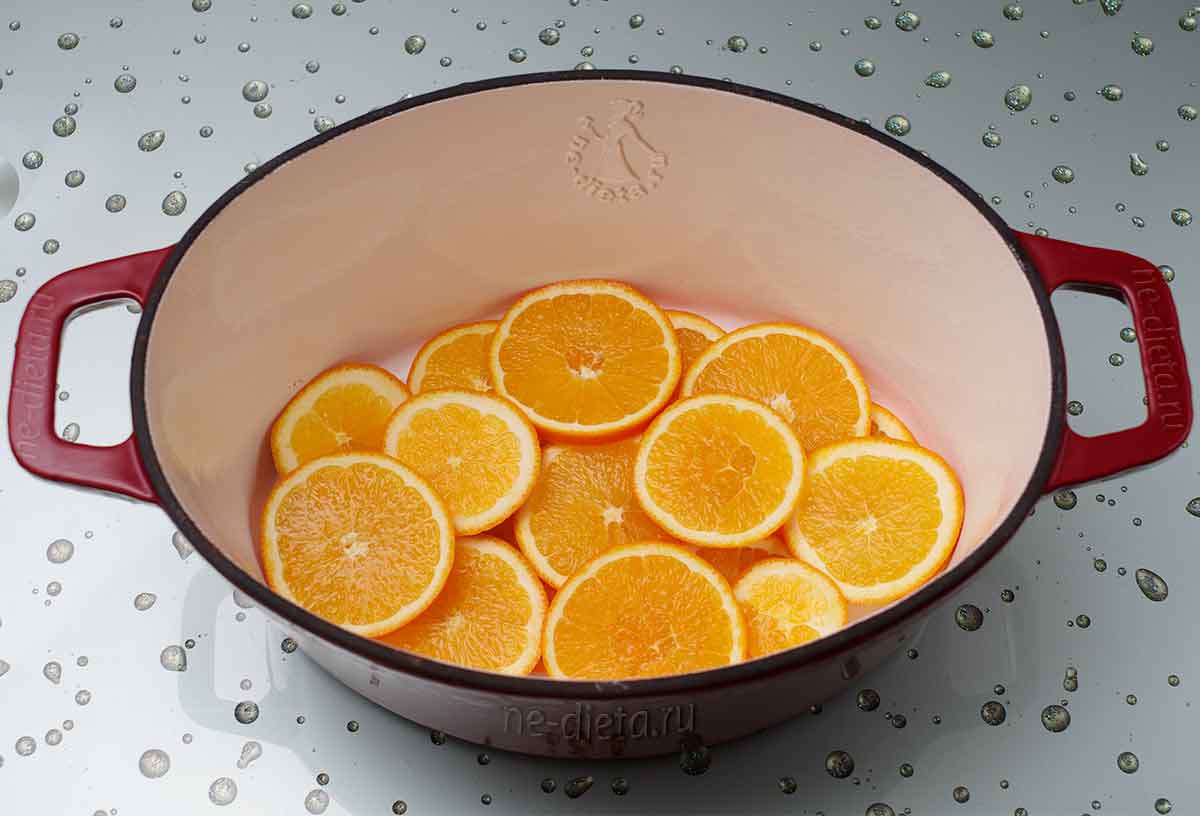
6. Coat the outside of the duck with the remaining glaze and place on top of the oranges.
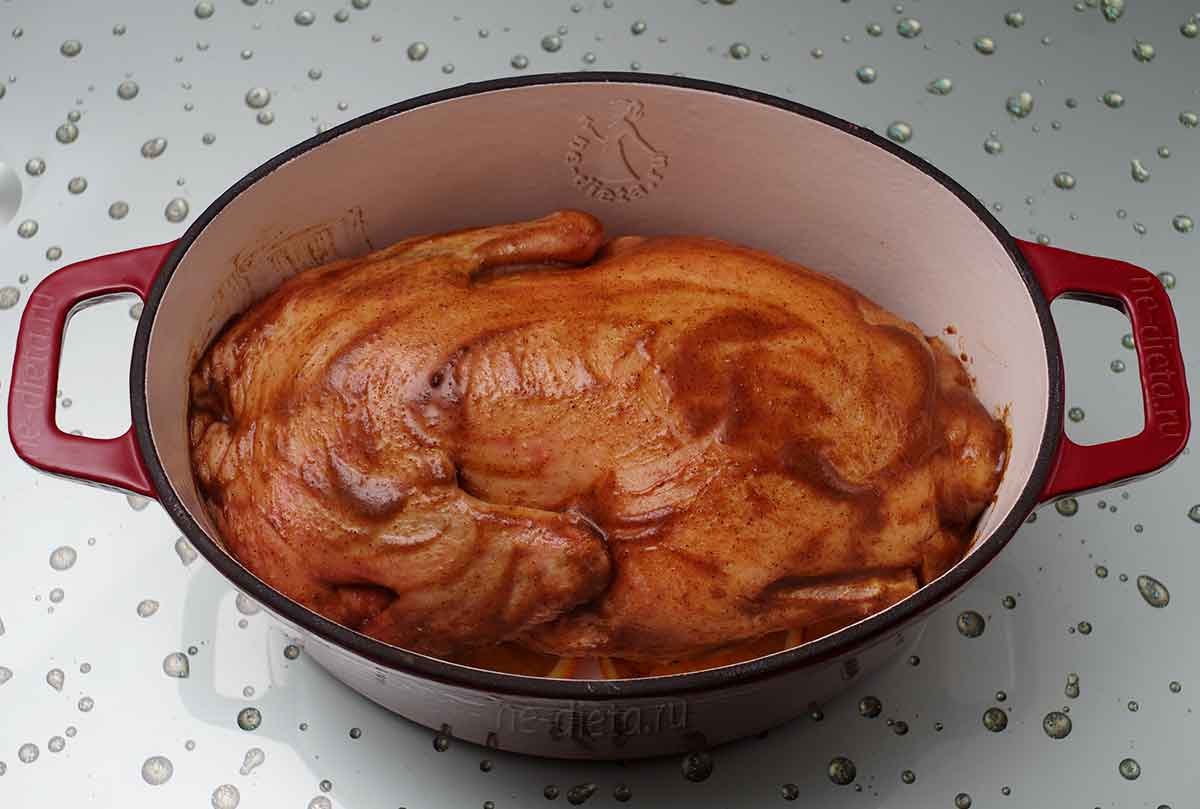
7. Cover the duck pot with a lid and place in an oven preheated to 180°C for 2 hours. After 30 minutes from the start of baking, you should begin to water the duck with the juice that accumulates at the bottom of the duckling pan every 20 to 30 minutes. 20 minutes before the end of cooking, remove the lid of the duck roaster to allow the duck to brown in the oven.
Advice! If you don’t have a duck roaster, you can cook the duck according to this recipe by placing it in a deep baking pan, where the juice and fat from the duck will drain. But in this case, the duck should be watered with juice as often as possible so that it does not dry out in the oven, and at the end of cooking, check its readiness by piercing it with a long knife between the thigh and back - if a colorless liquid flows from the cut, this means that the duck is ready. By the way, an hour before the duck is ready, you can put coarsely chopped potatoes on a baking sheet. Potatoes baked in duck fat will be an excellent aromatic and juicy side dish and, together with stewed sweet and sour apples, will complement the appetizing festive duck.
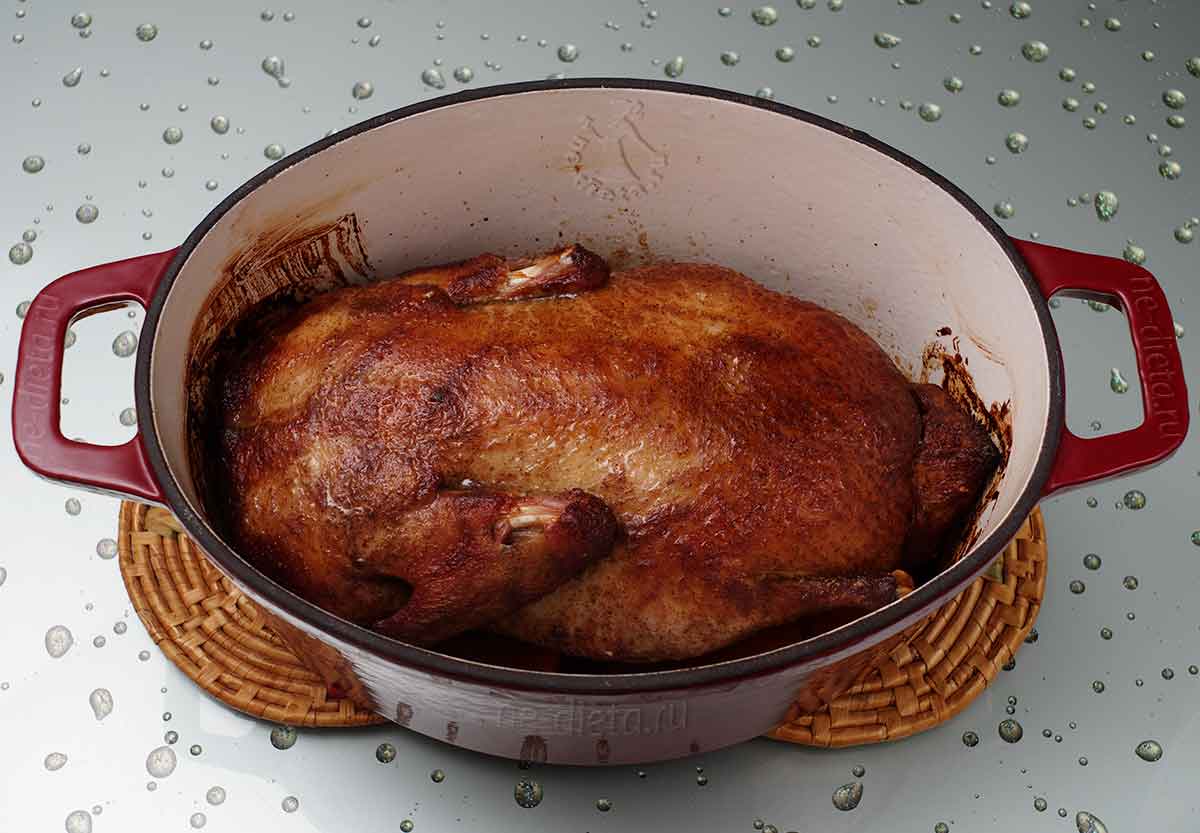
Rosy, juicy and incredibly tasty duck baked with apples in the oven is one of the best hot dishes that will perfectly decorate your holiday table. To impress guests, it is better to serve it on the table as a whole, and do not forget to serve stewed apples and cranberry or lingonberry sauce or jam along with it. Bon appetit!
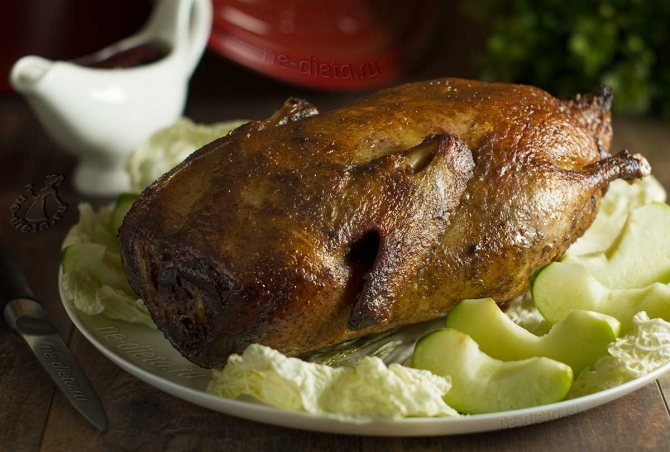
How to choose a duck carcass when buying
It is preferable to purchase a carcass of a young duck no more than six months old, and if it is a broiler breed, then it should not be more than three months old. Older ducks accumulate more fat and develop odors and specific tastes that not everyone likes. Although there are many duck meat lovers who value precisely this in duck.
The age of a duck is not difficult to determine. Juveniles have yellow legs, a soft beak, and transparent fat.
In addition, there are indicators that unmistakably indicate the freshness of the product :
- The skin of the carcass should be shiny and yellowish in color.
- The meat inside the carcass should be bright red in color. Brown or dark red tones indicate that the product is stale.
- The carcass should be elastic and, after pressing it with a finger, quickly restore its original shape.
Important! The skin of a duck carcass should never be sticky.
Bird selection
In order for duck to bring more benefit than harm to your health, you should carefully consider the choice of this product.
- Choose a carcass not in stores, but in markets. You will not be able to test the duck in the store, as it will be very frozen.
- At the market, choose only the seller who has all the stamps on the papers. Pay attention to whether the ducks have been checked by a veterinarian.
- Examine the carcass. The parts covered with sandpaper should be slightly shiny and slightly yellowish.
- A carcass that has been stored without violating the standards will not be sticky. Her skin will remain elastic - when you press on it, the resulting hole will quickly straighten back out.
- Look inside the carcass. The meat should be a beautiful, bright red color.
- You should not choose particularly large ducks - they will probably be old. Old ducks have a specific pungent odor, they are very fatty and quite sinewy. Therefore, you need to take an old duck only if you want to render fat from it; otherwise, it is of little use. Also, do not take a small carcass - young ducks are tough. It is best if the bird carcass is medium in size and quite meaty.
- If the duck's beak and legs were not cut off, you can evaluate the bird based on them. The younger the bird was, the softer its beak and the lighter its legs.
But it’s best to get your own supplier from a small farm where these ducks live. Then the duck on your table will always be of the highest quality possible.
Meat should be stored for no longer than 3 months.
Who can it harm?
As is the case with absolutely all products, duck meat is primarily contraindicated for people suffering from individual intolerance to it. The main risk factors for eating duck meat are related to its fat content, toughness, the presence of bad cholesterol and high calorie content.
Therefore, this product is contraindicated for those who:
- has problems with high blood cholesterol;
- suffers from disorders of the gastrointestinal tract and liver;
- has problems with the functioning of the thyroid gland;
- suffers from diabetes;
- is overweight.
Composition and beneficial properties
Duck occupies a special place among food products and its taste can only be underestimated by vegetarians who deny any products of animal origin in principle. But they might also be interested in knowing how healthy the meat of this “quacking” bird can be. In terms of vitamin content, it can be called a leader among representatives of the animal world, since it contains some B vitamins, including those that are quite rare in nature, vitamins A, E and PP. All of them have a beneficial effect on the functioning of human internal organs. The mineral composition of duck meat is also rich - it contains most of the elements of D. Mendeleev’s periodic table, including sulfur and cobalt, which are quite rare.
Cooking secrets
Over the long culinary history of duck meat, a wealth of experience in its preparation has been accumulated. Here are some of the necessary techniques that facilitate the cooking process and improve the culinary qualities of duck dishes :
- To prevent an unpleasant odor from being present in the dish, it is necessary to remove the anal part of the carcass before frying or baking;
- The juiciness of the meat is perfectly enhanced by fruit and berry additives in the form of classic sweet and sour apples, as well as oranges, lingonberries, grapes, cranberries and prunes;
- when using foil or sleeves to cook duck, they must be removed a quarter of an hour before the process is completed so that the carcass is browned;
- when baking, it is useful to baste the carcass with the fat rendered from it from time to time to obtain a crispy crust;
- quickly frying the breast over high heat avoids drying out the product;
- If you boil the duck carcass for 20 minutes before frying or baking, then in the end the product will never end up raw;
- the duck pan, no matter what it is made of, allows you to give the duck juiciness and flavor;
- when using a frozen carcass, it should be left in the refrigerator on the middle shelf a day before cooking and only then continue defrosting in the kitchen;
- To prevent the duck from being too fatty, you need to steam the carcass for half an hour, as a result of which the fat will melt and be removed from the product;
- the crispy crust beloved by many is formed on the duck if you pour boiling water over it before frying, avoiding boiling water getting inside the carcass;
- the meat will be more juicy after rubbing it with salt and leaving it on the refrigerator shelf for a day.
The nutritional value, or calorie content, of raw pork liver is 130 kcal per 100 grams. product
This is approximately 3 - 5% of the daily value. Of these, proteins account for 75.2 kcal; for fats - 34.2 kcal; for carbohydrates - 18.8 kcal.
What is the calorie content of pork liver prepared in different ways? And here it is:
Table of calorie content of pork liver, per 100 grams of product:
| Product | Calories, in kcal |
| calorie content of boiled pork liver | 109,0 |
| calorie content of stewed pork liver | 138,0 |
| fried pork liver calories | 211,0 |
| calorie content of pork liver in sour cream | 127,0 |
And the nutritional value of pork liver prepared in different ways is as follows:
Table of nutritional value of pork liver, per 100 grams of product:
| Product | Squirrels, gr. | Fats, gr. | Carbohydrates, gr. |
| boiled pork liver | 19,0 | 4,0 | 5,0 |
| stewed pork liver | 13,0 | 8,0 | 6,0 |
| fried pork liver | 17,0 | 12,0 | 6,0 |
| pork liver in sour cream | 14,0 | 6,0 | 6,0 |
Of course, this is not all that a product such as pork liver is valued for. Its calorie content is only one of many properties. Let us now turn to its culinary qualities.
Pork liver is boiled, fried and baked. It makes delicious liver pate, pancakes, liver cake, minced meat, which will be an excellent filling for pies, rolls or sausages. Many lovers of pork liver prefer it as an ingredient in a salad or simply as a side dish for boiled potatoes, stewed vegetables, loose rice, pasta or buckwheat. Some useful tips:
- It is recommended to salt fried pork liver at the final stage of cooking, so only fresh and high-quality product should be consumed, it will be softer
- to prepare gravy, where the offal is cut into pieces, you can add honey or sugar in a ratio of 0.5 kg per 1 tsp, this manipulation will give the liver more softness and tenderness
- hard liver should be simmered over low heat for half an hour, adding a little sour cream or sauce
- You can get rid of the bitterness that is characteristic of pork liver by soaking it for two hours; to do this, you need to fill it with milk or water and change the liquid once
- to cook delicious soft liver, it is recommended to pour boiling water over it and cook for forty minutes
What dishes can be prepared from pork liver? Yes, many. Here, for example, is a recipe for liver with sour cream:
